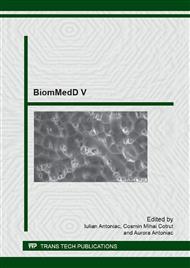[1]
M.Vert, Polymeric biomaterials: strategies of the past vs. strategies of the future, Prog. Polym. Sci. 32 (2007) 755-761.
DOI: 10.1016/j.progpolymsci.2007.05.006
Google Scholar
[2]
A. Sionkowska, Current research on the blends of natural and synthetic polymers: Review", Prog. Polym. Sci. 36 (2011) 1254-1276.
Google Scholar
[3]
A. Sionkowska, in: Current Topics in Polymer Research, edited by R.K. Bregg, NOVA Publishers USA (2005) 125-168.
Google Scholar
[4]
M.G. Cascone, Dynamic-mechanical properties of bioartificial polymeric materials. Polym. Int. 43 (1997) 55-69.
DOI: 10.1002/(sici)1097-0126(199705)43:1<55::aid-pi762>3.0.co;2-#
Google Scholar
[5]
P. Giusti, L. Lazzeri, S. Petris, M. Palla, M.G. Cascone, Collagen-based new bioartificial polymeric materials,. Biomaterials 15 (1994) 1229-1233.
DOI: 10.1016/0142-9612(94)90274-7
Google Scholar
[6]
M.H Struszczyk, Chitin and Chitosan: Part II: Applications of chitosan. Polimery 47 (2002) 396-403.
DOI: 10.14314/polimery.2002.396
Google Scholar
[7]
R. Muzzarelli, V. Baldassarre, F. Conti, P. Ferrara, G. Biagini, G. Gazzanelli, V. Vasi, Biological activity of chitosan: ultrastructural study. Biomaterials 9 (1988) 247-252.
DOI: 10.1016/0142-9612(88)90092-0
Google Scholar
[8]
N. Majeti, R. Kumar R, A review of chitin and chitosan applications. React. Funct. Polym. 46 (2000) 1-27.
Google Scholar
[9]
M. Rinaudo, Chitin and chitosan: Properties and applications. Progr. Polym. Sci. 31 (2006) 603-632.
Google Scholar
[10]
D. Kaplan, W. Wade Adams, B. Farmer, C. Viney, Chapter 1, Silk: Biology, structure, properties, and genetics, Am. Chem. Soc. New York 1994.
Google Scholar
[11]
E. S. Sashina, A. M. Bochek, N. P. Novoselov, and D. A. Kirichenko, Structure and Solubility of Natural Silk Fibroin, Russ. J. Appl. Chem. 79 (2006) 869-875.
DOI: 10.1134/s1070427206060012
Google Scholar
[12]
A. Sionkowska, A. Planecka, The influence of UV radiation on silk fibroin, Polym. Degrad. Stab. 96 (2011) 523-28.
DOI: 10.1016/j.polymdegradstab.2011.01.001
Google Scholar
[13]
O. Hakimi, D. P. Knight, F. Vollrath, P. Vadgama, Spider and mulberry silkworm silks as compatible biomaterials, Composites: Part B 38 (2007) 324–337.
DOI: 10.1016/j.compositesb.2006.06.012
Google Scholar
[14]
K. Lewandowska, Comparative studies of rheological properties of polyacrylamide and partially hydrolyzed polyacrylamide solutions. J. Appl. Polym. Sci. 103 (2007) 2235-2241.
DOI: 10.1002/app.25247
Google Scholar
[15]
E. Marsano, P. Corsini, M. Canetti, G. Freddi, Regenerated cellulose-silk fibroin blends fibers. Int. J. Biol. Macromol. 43 (2008) 106-114.
DOI: 10.1016/j.ijbiomac.2008.03.009
Google Scholar
[16]
S. Hirano, T. Nakahira, M. Zhang, M. Nakagawa, M. Yoshikawa, T. Midorikawa, Wet-spun blend biofibers of cellulose–silk fibroin and cellulose–chitin–silk fibroin. Carbohydr. Polym. 47 (2002) 121.
DOI: 10.1016/s0144-8617(01)00171-0
Google Scholar
[17]
C.R. Yoo, I.S. Yeo, K.E. Park, J.H. Park, S. Lee, W.H. Park, B.M. Min, Int. J. Biol. Macromol. Effect of chitin/silk fibroin nanofibrous bicomponent structures on interaction with human epidermal keratinocytes.42 (2008) 324-334.
DOI: 10.1016/j.ijbiomac.2007.12.004
Google Scholar
[18]
R. Schueller, P. Romanowski, Beginning Cosmetic Chemistry, 3rd Edition. Allured Buisness Media, USA (2009) 73-197.
Google Scholar
[19]
B. Bhushan, N. Chen, AFM studies of environmental effects on nanomechanical properties and cellular structure of human hair, Ultramicroscopy 106 (2006) 755-64.
DOI: 10.1016/j.ultramic.2005.12.010
Google Scholar
[20]
Y. Kamath, S. B. Hornby, H. D. Weigmann, Mechanical amd fractographic behavior of Negroid hair, Journal of the Society of Cosmetic Chemistry 35 (1984) 21-43.
Google Scholar


